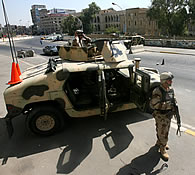2006年VOA标准英语-Wave of Sectarian Violence Continues in Baghdad(在线收听)
By Meredith Buel
Washington
15 September 2006
The escalation of sectarian violence continues in Baghdad, where officials say at least 50 bodies were found in a 24-hour period. In the past several days, officials say more than 100 people have been killed execution-style in the capital, despite a major security offensive by Iraqi and U.S.-led coalition forces. VOA correspondent Meredith Buel has more from Washington.
-------
 Iraqi army soldiers stand guard with their armored vehicle on a deserted street during prayer day vehicle ban, in Baghdad, Iraq, Friday, Sept. 15, 2006 |
||
Commanders are seeking to curb the sectarian bloodshed between Iraq's majority Shi'ite Muslims and minority Sunnis, who dominated the country for decades under Saddam Hussein.
In a teleconference from Baghdad for reporters at the Pentagon, General Chiarelli says the number of sectarian killings has gone down in parts of Baghdad targeted during Operation Together Forward, and soon that mission will expand to include parts of the city where dozens of bodies are being discovered every day.
"It is a city of seven million people," noted Chiarelli. "That is going to take time. This is not a short-term operation. I've just got to emphasize that. We have a city where we are trying to knock down sectarian violence and go after those folks, those death squads that have caused this new form of violence that, if left unchecked, could lead to civil war."
U.S. military officials say about 12,000 U.S. and Iraqi forces are sweeping through Baghdad neighborhoods, securing buildings and seizing about 1,200 weapons.
Some of the U.S. troops for the Baghdad operation have come from other areas of Iraq, including Anbar Province, a vast area in the western part of the country that reaches to the borders of Syria and Jordan.
Recent stories in U.S. newspapers quoted a report from a senior American military intelligence officer that offered a "very pessimistic" view of efforts to secure Anbar, considered the heartland of the Sunni insurgency.
The report prepared by Colonel Peter Devlin, the chief of intelligence for the U.S. Marine Corps in Iraq, reportedly says there are no functioning Iraqi government institutions in Anbar, creating a vacuum that is being filled by insurgents linked to al-Qaida. Colonel Devlin reportedly argues that, without an infusion of more U.S. troops and financial aid, the already grim situation in Anbar will continue to deteriorate.
During his briefing, General Chiarelli acknowledged that U.S. troops were shifted from Anbar to support the operation in Baghdad, because, he says, securing the capital is now the top priority of coalition forces
Chiarelli said the U.S. is working with the Iraqi government to improve the poor economic situation in Anbar that is adding fuel to the insurgency."When you go to a governor, when you go to a local official, and you ask them, 'what can we do to lower the level of violence?,' their Number One answer, the thing they always tell us, is 'find jobs for the angry young men,'" said Chiarelli. "We need help, and we have a commitment from the Iraqi government for help, and as quick as we can get that help out there to start working those economic conditions, I think that is, in fact, a strategy for victory."
Of the approximately 147,000 U.S. troops in Iraq, about 30,000 are in Anbar province.
General Chiarelli says the U.S. military will not leave Anbar, and he says efforts to stabilize the province are moving in the right direction.